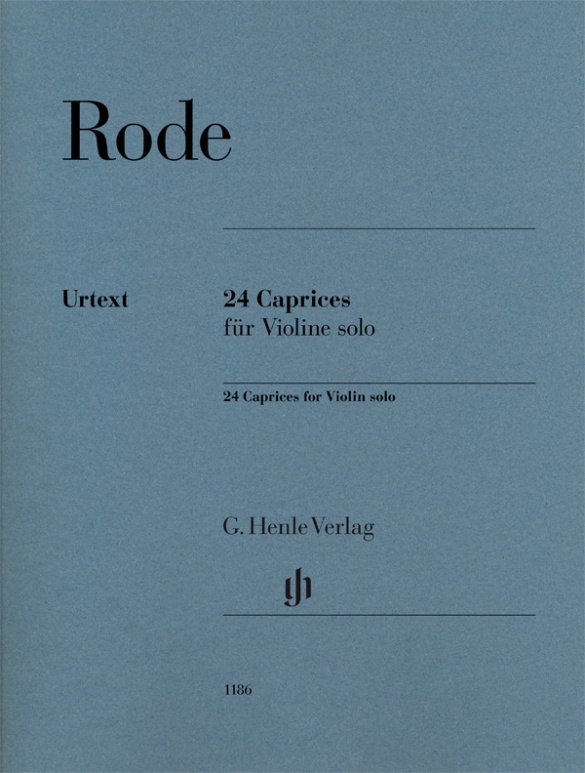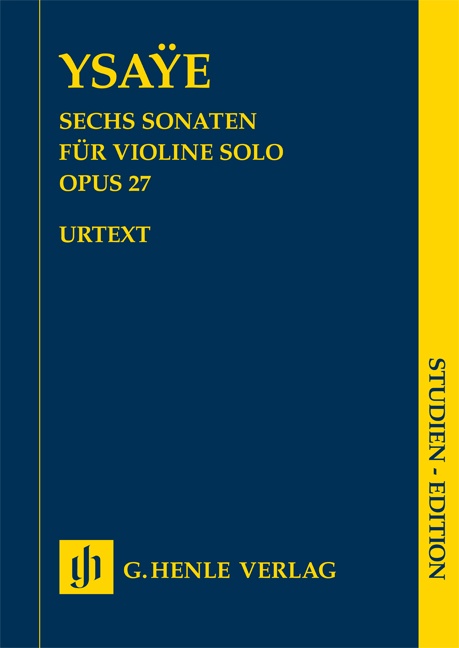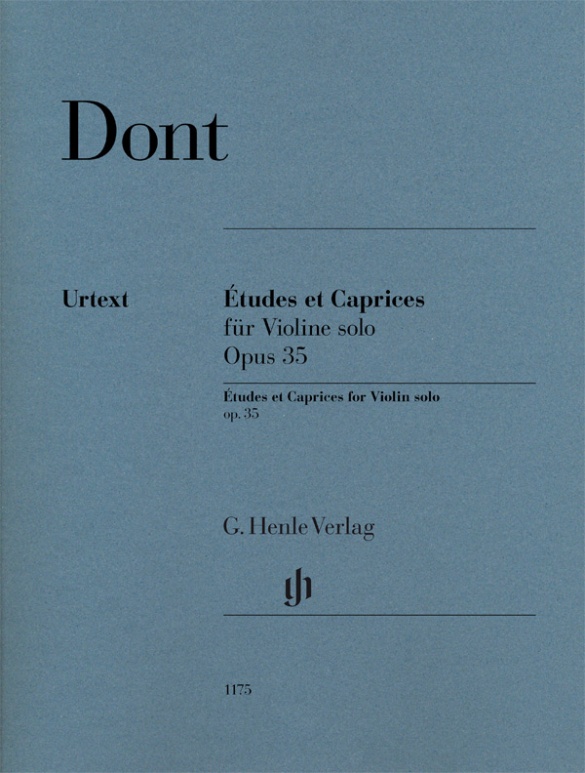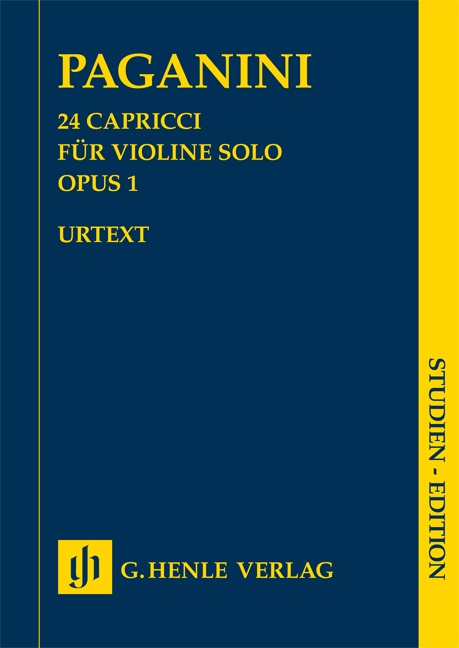

Nicolò Paganini
24 Capricci op. 1
Nicolò Paganini’s milestone in violin literature is now not only available in a practical Urtext edition (HN 450) but also as a study score. Published in 1820 as his Opus 1, Paganini gave the violin world a timeless masterpiece, which no up-and-coming violin virtuoso can ignore.
As well as the musical text, our edition also contains a must for all interested performers: a detailed commentary by the Paganini expert Renato de Barbieri. With numerous examples and illustrations for each of the 24 Capricci from the autograph, he knowledgeably explains the characteristics of Paganini’s notation and its significance for its interpretation today.
Content/Details
Exclusively in the Henle Library APP
Fingerings by: Ivan Galamian, Ruggiero Ricci, Ulf Wallin
About the Composer
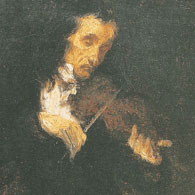
Nicolò Paganini
Violin virtuoso and composer of violin music of a unique and virtuosic character. He composed numerous works for violin and orchestra, pieces for solo violin, and chamber music for violin and guitar, as well as other chamber works. In pieces for the G string, like his Sonata Napoleone and Sonata Militare, he experiments with tone colors (harmonics and pizzicato for the left hand).
| 1782 | Born in Genoa on October 27, the son of a harbor worker and amateur musician. First musical education from his father, then from professional violinists. |
| from 1794 | Concerts in churches and for private audiences. Studies composition in Parma with Paer and Gasparo Ghiretti. He writes a great deal of music for guitar. |
| 1795 | Performance in Genoa of the Polish violinist Duranowski, who inspires Paganini. |
| 1801–09 | He lives in Lucca: there in 1805 he becomes first violinist of the city’s Cappella Nazionale. |
| before 1818 | Twenty-four Caprices, Op. 1 (published 1820), which inaugurate the genre of the concert etude. |
| 1805–09 | He composes 45 sonatas. |
| 1810–24 | First concert tour through Italy. |
| 1813–1815 | Guitar Quartets, Op. 4 and Op. 5 |
| 1816 | Violin Concerto No. 1 in E-flat major, Op. 6: conventional concerto–sonata form with very virtuosic passages for the solo instrument. |
| 1825–27 | Second concert tour of Italy. |
| 1826/28 | Violin Concertos No. 2 (B minor, Op. 7) and No. 3 in E major. |
| 1828–34 | Spectacular performances in European cities. |
| 1830 | Publication of a Paganini biography by Julius Schottky. Violin Concertos No. 4 (D minor) and No. 5 (A minor). |
| 1837 | The long-term establishment in Paris of a concert establishment, the Casino Paganini, fails. |
| 1840 | Death in Nice on May 27. |
About the Authors
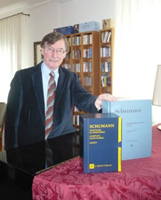
Ernst Herttrich (Editor)
Dr. Ernst Herttrich, born in 1942 in Würzburg, read musicology, history, German and theology at the universities in Würzburg and Cologne. In 1970 he earned his doctorate in Würzburg with a study of the expression of melancholy in the music of Mozart.
From 1970 to 1990 he was an editor at G. Henle Publishers in Munich, after which he was Head of the Beethoven Complete Edition for over 15 years. In 1999 he took over as Head of the Beethoven-Haus Publishers, and from 2001 was made Head of the Beethoven-Archiv, the research centre at the Beethoven-Haus.
He has been a visiting professor at Meiji Gakuin University in Tokyo and has undertaken several lecture tours both there and to Kyoto. His research interests include source studies, editorial techniques and music history. Herttrich’s publications include “Beethoven. Liederkreis an die ferne Geliebte” (Bonn 1999) and “Ludwig van Beethoven. Biographie in Bildern” (Bonn, 2000). Herttrich has edited over 100 Urtext editions for G. Henle Publishers.
Product Safety Informations (GPSR)

G. Henle Verlag
Here you can find the information about the manufacturer of the product.G. Henle Verlag e.K.
Forstenrieder Allee 122
81476 München
Germany
info@henle.de
www.henle.com
Tobias Glöckler ist in seiner Ausgabe sehr umsichtig vorgegangen. So sind in den Noten nicht nur die Eintragungen Spergers kenntlich gemacht, sondern auch zahlreiche offene Fragen erläutert. Wenn Notationen, Oktavierungen, Artikulationen, die sich in Spergers Abschrift finden, nicht eindeutig zu interpretieren sind, so erfährt man dies ebenfalls im Vorwort. Fußnoten an zahlreichen Stellen geben weitere Hinweise. Informationen zur heutigen Interpretation damals zeittypischer Notation, etwa von Artikulationszeichen, stehen ebenfalls im Vorwort und geben Impulse, sich vertiefender mit dem Werk auseinander zu setzen. Früher sind Werke klassischer Kontrabassliteratur meist in Orchester- und Solostimmung verlegt worden. Inzwischen wird zunehmend auch für das tiefste Streichinstrument historisch informiert gedacht. Zahlreiche Bassisten beschäftigen sich mit der "Wiener Stimmung", für die viele Werke komponiert wurden und die aufgrund zahlreicher Flageolets eine völlig andere Klangfarbe im Spiel ermöglicht. Tobias Glöckler geht in seiner Ausgabe einen Kompromiss ein, um möglichst vielen Musikern das Spiel in "Wiener Stimmung" zu ermöglichen. Eine Solostimme ist als Griffnotation notiert, sodass das Konzert auch mit einem modernen, umgestimmten Instrument spielbar ist. Eine Übersicht über Kontrabassstimmungen und Aufführungsmöglichkeiten ergibt in dieser Ausgabe vier Varianten mit einem Klavierauszug in D-Dur und C-Dur. Der Druck ist übersichtlich und es gibt gute Wendemöglichkeiten. Neben Kadenzen von Tobias Glöckler selbst, die im Notenfluss gedruckt sind, finden sich auch diejenigen von Johann Sperger im Anhang.
Das Orchester, 2016This is an ideal booklet for the studio teacher.
Strings Magazine, 2013Die vorliegende Ausgabe fußt auf dem Autograph und korrigiert die vielen, die ursprüngliche Intention Paganinis verzerrenden Fehler.
ESTA Nachrichten, 2014recommendations
autogenerated_cross_selling
Further editions of this title
Further editions of this title


